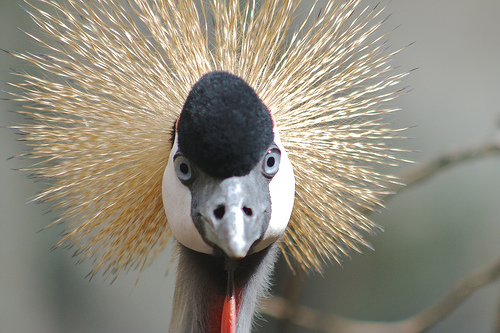We went to the Zoo today, and I brought along the Canon EF 75-300mm f/4-5.6 USM MK II lens. I wanted to try getting up close and personal with some of the animals, which is something I hadn't really tried before. I've usually gone with the point-and-shoot, or just the kit 18-55mm lens on the XT. This was the first time I tried shooting animals at 300mm. I wound up taking 178 photographs. I kept 18, and I'm really quite happy with the shots that survived the cut.
The technique I was trying was to get as close as possible, then get even closer. Many of the shots I like the most from this visit are shots that would have been uncomfortably "close" if I wasn't forcing myself to get closer. The second shot of the East African Crowned Crane, for example, might normally have been shot such that the entire crown was included. But by getting even closer, I think the shot is much more interesting.

I was shooting without a tripod or monopod, so wanted to force a fast shutter. I bumped the ISO to 800 (on a bright sunny day) and shot in Aperture Variance mode with the aperture cranked wide open. The theory being, if I force as much light as possible onto the sensor, I'll compensate for hand-holding.
Except that I accidentally screwed up royally. Somehow, I'd inadvertently twiddled the buttons and knobs and wound up setting the exposure compensation to be 3 stops higher than normal. Meaning every single shot was terribly overexposed. Unbelievable, painfully overexposed.
Thank the gods I shoot in RAW, and use Aperture. Aperture freaking rocks. On most shots, all I had to do to rescue it was to drag the "Exposure" slider to the left. That's it. On others, I had to futz with Highlights and Shadows, and Levels on a couple others. A few shots that had lots of light or white wound up with so much lost data that they were lost. But the vast majority were saved, and were actually acceptable.
Lesson learned - check all camera settings before starting a shoot or project. ISO. Exposure compensation. Maybe even image size and format (make sure it's in RAW). Aperture may be an amazing tool, but it's just plain silly and reckless to fall back on editing and manipulation to rescue images, if that could have been easily prevented by just properly setting the camera. But, it's good to know that if Something Bad Happens, I can pull some useful images out of an otherwise garbage roll.
